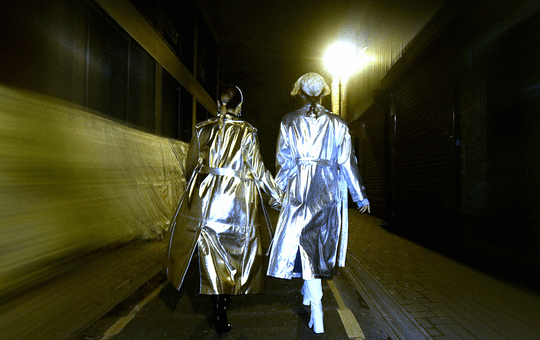Unsound report
‘Everything has ended, and everything ends’; so goes the title for the second last event of Unsound 2012, pre-empting its finish before it’s begun. It’s a surreal experience to watch the festival staff packing up the press office, taking down their ‘The End’-themed posters, as if this is what the entire programme was geared towards in the first place. But then, it kind of was. Not only with its rich inter-textual interrogation of the very peculiar concept of ‘endings’ themselves, but on a basic level, the moment where the exhausted, hardworking staff can call it a day and collapse into oblivion. But before that (or was it after?), there would be eight days of seemingly disparate, yet somehow related interactions between artist and audience, sound and image, criss-crossing a boundless stretch of time and space.
Julia Holter and the Sinfonia Iuventus Quartet perform in the Gothic setting of St Catherine’s Church, where Holter’s expansive songs are revealed for the timeless melodies they are among strings and stone. It’s a tranquillity to be torn apart by the bodily rumble of Tim Hecker and Daniel Lopatin’s collaboration to follow. The latter’s familiar pitch-shifting vocal samples and simulated wind pipes rise from a sonic barrage, only to pass through 16th century pillars and transform the entire structure into an instrument. The very incarnation of the apocalypse, it’s a building beset by a history of war and political upheaval, but conquered by sound alone.
Julia Holter performs at Unsound 2012.
At Steve Warwick’s ‘Heatsick Presents: Extended Play’ the following night, techno-informed master of vocal processing, Holly Herndon, is witnessed carrying on dancing front-of-stage well into the wee hours despite appearing physically destroyed, slightly late and uncannily articulate for a discussion panel on Post-humanism earlier that day. Although not a proponent of said theory herself, Herndon becomes the personification of physical transcendence as the compound energy of Heatsick’s slow-burning build-up reaches crescendo pace over an incredible three hours of original material –convulsing audience in tow.
Heatsick perform at Unsound 2012.
Jostling for equally-deserved attention that same night is Fatima Al Qadiri’s wild compound of digital abundance absorbed, digested and expelled through a crush of muslim chants, Bollywood pop and Rihanna’s Where Have You Been. Russian-born producer Slava’s coiling sample of Britney Spear’s Slave 4 U for the mangled DnB-indebted beats of What I Feel Like Doing complements the room’s sense of cross-cultural interaction, while a Japanese fan, dressed in a white cotton onesie and lit up by twinkle lights, mourns his forgotten earplugs. Powerhouse party-scene veterans Nguzunguzu move from on-stage spectators and Al Qadiri supporters to conscious momentum-builders as Daniel Pineda inadvertently parodies the ‘grand ego’ Hieroglyphic Being eschews by gesturing to up the tempo from his already seething audience, with a flick of the wrist and a wry grin.
Nguzunguzu perform at Unsound 2012.
Ideas of rhythm and revolution, not only in the physical sense of music and its production but in the circular relationships among artists across genres and generations resonates in the set of techno icon Theo Parrish. Gathering strength over an extended stint of old disco and funk, contemporary R&B and a murky jazz sample of Nirvana’s Smells Like Teen Spirit, the rapturous DJ’s eclectic taste equals that of record-collector Hieroglyphic Being’s broad palate that includes the “deep and sexy” vibes of Simply Red. Theirs is the crackling, analogue version of the compressed and digitised aesthetic of the aforementioned DL generation.
That sense of reuse and recycling is not only reflected in a creative universe of infinite references influencing the likes of Evian Christ’s reappropriated and fucked-with macho-pop anthems, but in the festival’s clever and considered use of physical space. There’s the PAN showcase at Feniks Dance Club, once a savings association built in the 1930s, usually a dinner club for the middle-aged, now the blood-red and gold setting for the anxious psychoacoustics of Brooklyn artist Ben Vida. Then there’s the modernist remnant of Communism, Hotel Forum, playing host to the bulk of the late-night saturnalias and cloaked by a colossal advertisement for condoms. And, what could be more symbolic of a world in flux than this modern image of atomised individualism-cum-corporate takeover obscuring this emblem of an equally oppressive old world order?
Interplanetary Prophets (Ital & Hieroglyphic Being) debut their live show at Unsound 2012.
After all, as much as I’d like to recognise Aurora Halal’s eerily gauche VHS collages from a rolling bill of unnamed visual artists presented alongside each performance (and don’t get me wrong, I do identify it during the Ital and Hieroglyphic Being collaboration, Interplanetary Prophets, pictured above) it’s interesting to consider the de-individualised, anonymous outcome of the technocratic dream that is the world wide web and transmedia universe.
Where last year’s ‘Future Shock’ despaired over the overload of information and dead data perpetuated by the mass communication, ‘The End’ – despite its implied negativity – becomes a hopeful nudge towards the endless scope of human progress. This is where we return to where we began, with Demdike Stare and Sinfonietta Cracovia’s elegant audio-visual collaboration at the Tempel Synagogue with animator Michael England. Here, at ‘Everything Has Ended, and Everything Ends’, the spiritual and scientific visuals of their ‘Concealed’ commission are presented alongside Sza/Za/Ze’s brilliantly intuitive, sometimes tickling, soundtrack to the surreal 1930s shorts of Stefan and Francziszka Themerson. It’s that pairing that shows a creative scope that is comparable across a chasm of 80+ years, while proving that technology might have changed, but the human capacity for imagination hasn’t.













